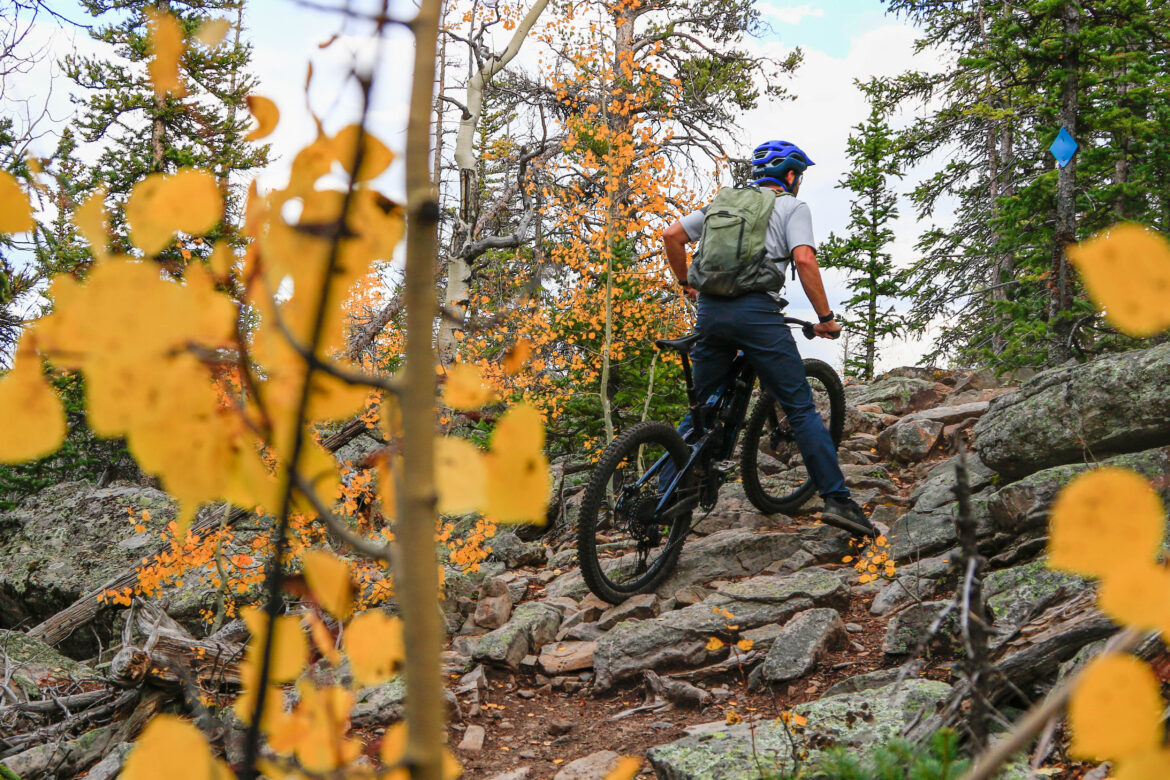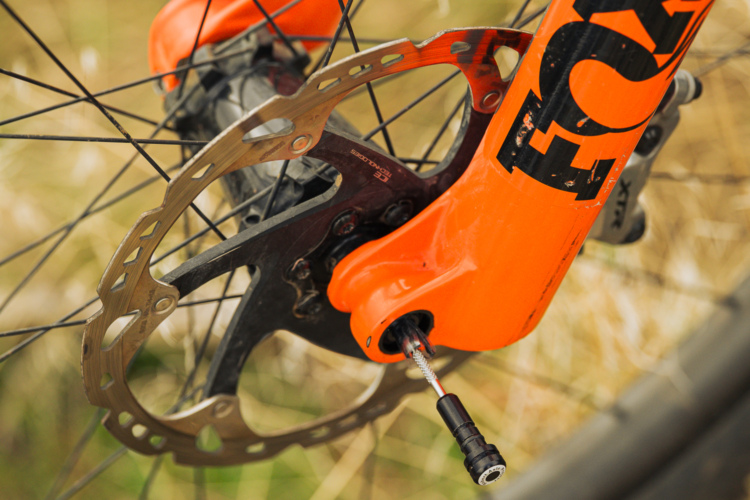
When winter sets in, many mountain bikers trade their bikes for skis or snowboards and hit the slopes. Unfortunately, that’s not me. I don’t have an off-season activity I can start doing when the snow flies. Fortunately, I live in a place where, despite the snow, I can stay riding my mountain bike nearly year-round.
From late spring to late fall, most mountain bikers are riding trails on the west side of Bend, Oregon, where I grew up and currently live. When the snow sets in, we head east, to Bend’s winter riding trailheads. These areas are much dryer and get much less snow than the west side, which sits on the edge of the Cascade Mountains.
The winter riding trails in Bend are also distinctly different than the summer trails. They are steeper, much chunkier, and generally shorter, as they take advantage of elevation from buttes around the city. In contrast, the summer riding in Bend has a lot more flow, is more groomed, and tends to be a bit more pedal oriented.
I don’t dread the change in seasons as it actually gives me something to look forward to—riding at trails that I haven’t for nearly a year. But, with such fewer winter trails, I knew going into this last winter riding season that boredom would soon set in. To combat this inevitability, I decided to be intentional about my winter riding—I wanted to work on the weakest aspect of mountain biking for me: technical climbing.
With our winter riding trails naturally being steeper and rockier, I felt they were the perfect playground to work on this goal. And, I did it! It was mid-April, and I finally climbed, no dabs, Escape From Moscow, a techy black trail at Horse Ridge, one of Bend’s winter riding spots. As I continued up the trail, I reflected on exactly what I did to get me to that point.
Setting a Specific Goal
My initial goal, if you want to call it that, going into the winter riding season was to work on my climbing. While that is certainly an admirable goal, it is a goal that can seem rather subjective and relative when it comes to measurements. Simply put, how am I to know I am “a better climber” at the end of this season? How do I measure my outcome?
When thinking of this goal, I couldn’t help to think back to my time as a teacher and setting goals for students. Often, teachers set goals with the same problem. We may set a student with the goal of being more attentive during class. What this goal lacks are measurable ways for that student to indicate they are being successful. Now, let’s take the same student that we want to be more attentive to. If their goal is more specific, like having their eyes on the teacher while the teacher is talking, there is an actual, reasonable thing for the student to do, and the teacher to track.
So, knowing my initial goal was good but fairly vague, I revised my goal to be more specific. While descending the trail I mentioned before, Escape From Moscow, I often saw riders attempting, and successfully climbing it. My goal then became climbing Escape From Moscow without putting a foot down. I now had an attainable, measurable goal—I would either climb the trail or I wouldn’t.
Start Small
After I determined that I was going to clean Escape From Moscow, I attempted to climb it every time I was out there. Climbing the trail starts you off on a mile-long, sandy grind that brings you up nearly 400 feet. A big left-hand turn puts you at the bottom of the difficult section of the climb. Four techy, punchy, and winding sections lay ahead, each with its fair share of square-edged rocks.
“Just go,” I would tell myself as I sat at the bottom of these four problems. And that’s what I did. Without much of a plan, I would set off hoping to be able to clear each section. My results were varied.
One day, I would get the bottom and top sections but have to put a foot down on the middle two. Another day, the bottom section, which I may have cleaned in my previous attempt, proved too challenging for me. Despite getting to the point of cleaning each of the four sections at different times, I couldn’t seem to string them together.
I realized that my thought process was on the entirety of the climb, rather than each individual section that I rolled up to. I needed to break this climb up, take each section one at a time, until I knew the lines and the pedal strokes almost subconsciously. For some sections, I even broke those into separate parts. I needed to start smaller and think of this climb as individual problems to solve, each leading to the next before I solved the whole.
This meant a several-day, eventually leading to a several-week process. But it worked. I focused on the bottom section only for a while. Eventually, my line was clear, I knew when to pedal, and where I needed to exert myself the most. The bottom section quickly became a pedal-through as I started working on the next section. This pattern continued until I reached the last of the four sections, where I began to think of all four sections as an entire climb once again.

Going Solo
Nobody likes to be the person that feels like they are holding up the group. Have you been there? Have you ever been the last person to the top, still trying to catch your breath as your buddies start down the descent? I certainly have and I wouldn’t be honest if I didn’t include that reasoning into why I wanted to work on my climbing.
More than that, though, it seems like we are all chasing the descent. “Earn your turns” becomes our motto, with the enjoyment certainly being on the “turns.” We love the descent, the feeling, the rush, the adrenaline. For many of us, going down is the reason we go up. I am no different.
Knowing this, I certainly don’t want to be the guy who is holding the rest of the crew up. “Hold on, guys, let me give this one more shot,” as I run my bike back down where a particular section starts, for the 4th time. I can just imagine the groans from my buddies as they watch me struggle up a techy part of the trail again and again.
Now, there is a very good chance that this is all in my head. The folks I have had the pleasure of sharing the trail with, like most mountain bikers, are pretty laid back and love seeing fellow riders progress. I’m sure most of us would mind a friend giving something a few attempts. However, a group ride is a group ride, and there comes a point where multiple attempts on the same section of trail becomes inconsiderate of others. Having both of these realities in mind, I decided the times I would really be working on my goal were solo rides.
More than anything, this freed up my mind to try something 7 or 8 times. I could keep walking down and pedaling back up without the feeling of somebody waiting for me. Maybe I was being overly self-conscious, maybe my friends wouldn’t mind waiting for me. Regardless, I was able to put that out of my mind and focus entirely on the section I was trying to conquer.
Riding To Climb
Similarly to deciding to ride by myself, I also had to make a conscious decision to consider the climb as my ride. With work, family, and the general business of life to get back to, most of my rides consist of me hustling to the top as fast as possible. Extra time is not left for multiple attempts on difficult climbing sections, it is for hiking back up my favorite parts on the descent. If I scramble to the top as fast as possible, I may even get 3 or 4 times to hike back up a section on the descent.
This was a mentality I realized I had to change. My desire to get to the top was leaving me with time for maybe 3 attempts on the tough sections of the climb. If I didn’t get it by then, I’d hike the rest so I could get on to the descent. My lack of progression was apparent and I knew that I needed to shift my mindset.
Climbing became my reason to ride when I was working on my goal. I would set out knowing I would spend the entirety of my ride working on the four difficult sections if I had to. There was no more focusing on the top, no more giving up on the climb so I had time to descend. If the climb was all I did, that’s all I did. If I ran out of time, I would just head back to the car.
Fortunately, that only happened once. What really surprised me was when I made the decision to focus on the climb, I started to see real progress. My determination to get a part I’d been messing up on fueled my attempts. Finally cleaning a particular section felt like the first time I hit a jump or drop I’d been eyeing for a while. I was able to focus on the climb, accomplish what I needed, and still make it to the top for a descent.
Honorable Mentions
These 4 things stick out in my mind when I reflect on what I did to accomplish my goal of climbing Escape From Moscow. However, there are a couple of other things that played a factor.
First is ratcheting. If you are unfamiliar, ratcheting is the use of a partial backpedal to forward pedal once again, without doing a full rotation. This is typically used in technical climbing situations, where pedal strikes are abundant. Ratcheting isn’t something that came naturally to me, so I practiced it on simple terrain, with the hope of it becoming a regular rhythm for me.
A new wheelset also came into my life at this time. This new wheelset took me from hubs with 18 points of engagement to 90 POE. It was a day and night difference. Do I think that I could have cleaned that climb on my old wheels? It would have been harder, but I do. Do I think it was purely a coincidence that my first time cleaning the entirety of Escape From Moscow was on those higher engagement hubs? No, I don’t.


















15 Comments
May 17, 2023
May 17, 2023
May 17, 2023
May 18, 2023
Run a singlespeed annnnnd, you'll get strongfast.
May 17, 2023
May 18, 2023
May 18, 2023
May 18, 2023
May 18, 2023
May 18, 2023
May 18, 2023
May 22, 2023
May 24, 2023
May 24, 2023
Jun 1, 2023